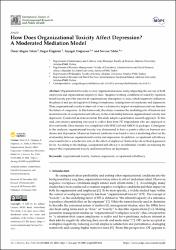How Does Organizational Toxicity Affect Depression? A Moderated Mediation Model
Abstract
Organizational toxicity is a key organizational issue today, impacting the success of both employees and organizations negatively alike. Negative working conditions revealed by organizational toxicity pave the way for an organizational atmosphere to arise, which negatively influences the physical and psychological well-being of employees, causing burn-out syndrome and depression. Thus, organizational toxicity is observed to have a destructive impact on employees and can threaten the future of companies. In this framework, this study examines the mediating role of burnout and moderator role of occupational self-efficacy, in the relationship between organizational toxicity and depression. Conducted as cross-sectional, this study adopts a quantitative research approach. To that end, convenience sampling was used to collect data from 727 respondents who are employed at five-star hotels. Data analysis was completed with SPSS 24.0 and AMOS 24 packages. Consequent to the analyses, organizational toxicity was determined to have a positive effect on burnout syndrome and depression. Moreover, burnout syndrome was found to have a mediating effect on the relationship between organizational toxicity and depression. In addition, occupational self-efficacy was found to have a moderator role on the effect of employees’ burnout levels on their depression levels. According to the findings, occupational self-efficacy is an influential variable on reducing the impact that organizational toxicity and burnout have on depression. © 2023 by the authors.
Source
International Journal of Environmental Research and Public HealthVolume
20Issue
5URI
https://www.scopus.com/record/display.uri?eid=2-s2.0-85149933474&origin=resultslist&sort=plf-f&src=s&nlo=&nlr=&nls=&sid=20c4fe371b9b908d4f7e419f791331ff&sot=aff&sdt=cl&cluster=scofreetoread%2c%22all%22%2ct&sl=72&s=AF-ID%28%22Alanya+Alaaddin+Keykubat+University%22+60198720%29+AND+SUBJAREA%28MEDI%29&relpos=11&citeCnt=0&searchTerm=https://hdl.handle.net/20.500.12868/2331
https://www.mdpi.com/1660-4601/20/5/3834


















